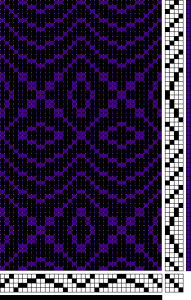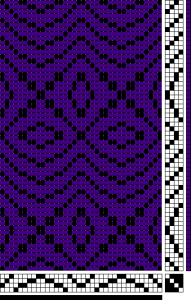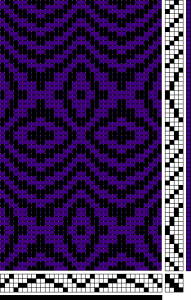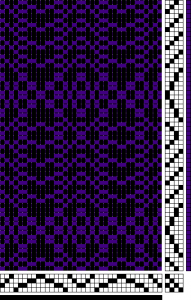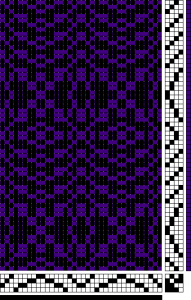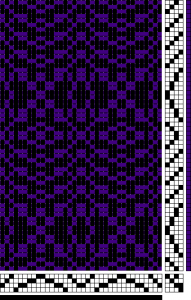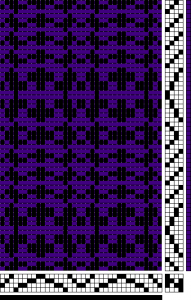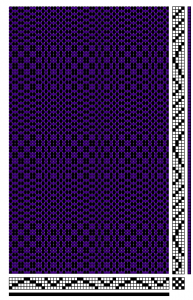(Almost) Infinite Variations
A four-shaft loom makes a great first loom. One could spend a lifetime weaving on it and still not exhaust all possibilities. — Marcy Petrini
I’ve been playing with variations on a single theme — a 4 shaft pattern where I change only the tie-up; the threading and treadling remain the same. With a twill tie-up, it looks like Figure 1.
4 Shaft Wif Design Wif file It is nice and thin and curvy. There is a potential problem with it — it has a rather long warp float – 10 threads long, so it may not be practical for all fabrics — in a balanced weave with a 10 threads per inch, this means that the float would be one (1) inch long — possibly ok for a scarf or a shawl, but not very good for other uses. In a moment we’ll take a look at how to help that — the results won’t be perfect, but they’ll be better.
One quick way we can vary the design is to simply reverse the tie-ups, which will give us Figure 2. Reversed Tie-up. This time, the float is in the weft — we’ve simply reversed the face of the fabric.
Unfortunately, this design doesn’t work well with counterbalanced looms — they tend not to like lowering only one shed at the expense of the others. Modifying the tie-up so it will work better with a counterbalance loom produces Figure 3 and its Counterbalanced Tie-up WIF file. It is bit more bulky in the pattern, however now the longest float is 6 threads which makes it a bit more practical — given that same ten (10) thread per inch weave from before, the longest float is just over half an inch.
Another variation can be seen in Figure 4 (4-shaft-niftyness-part-tabby) where two treadles are used to weave tabby and the other two have shafts three and four respectively. With this variation, the warp has a float of six threads and the weft ten. It also looks quite a bit different from the original design.
Figure 5 (Part Tabby Variation Wif)is different yet; it has warp and weft floats of three and five threads. Inverting it as in Figure 6 (Part Tabby Variation Reversed WIF), however, brings back the 10 thread float in the warp. Yet another variation can be seen in Figure 7 (Long Floats WIF). This reminds me a little bit of Space Invaders. It also has a warp of 10 threads in the weft. Inverting this still leaves the weft float at the same length.
The last variation that we’ll look at here is a pure tabby tie-up, in Figure 8
(All Tabby WIF) where the longest float is two threads. This one is pretty neat, it appears to undulate in parts. Also, it bears little, if any, resemblance to the original pattern.
I hope that this post has helped to illustrate how much variation can be achieved simply by modifying the tie-up of a pattern. In writing it, I’ve learned more about how the tie-ups can affect not only the pattern, but the structure of the fabric.
I used Weave Design to create the various WIF files, and The Gimp to produce the images. Both of these tools are quite valuable. Weave Design enabled me to quickly change the tie-ups and see how it affected the design.
